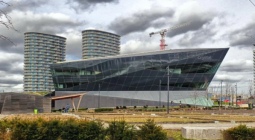How can the construction sector combat climate change?

In celebration of Earth Day 2021, Marialena Nikolopoulou, Professor of Sustainable Architecture in the School of Architecture and Planning shares her thoughts on the role the built environment sector plays in the fight against climate change:
‘There is a lot that the UK built environment sector can do to have a positive impact on the environment. Buildings and the construction sector account for about 40% of CO2 emissions globally, so there is a lot we can do at different stages from design, construction and operation of buildings to address the problem.
‘In New London Architecture’s Zero Carbon London report, they surveyed built environment professionals from over 100 sector companies to gain insight into where the profession stands against climate change. Of those asked what measures can be prioritised in London to have the biggest impact in achieving net zero targets, the top response was that 90% of the work of built environment professionals should become retrofitting.
‘It is important not only to design buildings from scratch, but also to consider existing buildings. What do we do with the building stock that already has a lot of embodied carbon? How do we effectively refurbish the existing building stock? In cities, particularly in the UK, this is a big resource that we must take into account.
‘Cities as a whole account for nearly 80% of CO2 emissions globally, so must be considered part of the ecosystem. Cities are an interconnected system of buildings, streets and infrastructure networks. Concrete and asphalt are materials that absorb and retain heat, causing temperatures to rise, leading to urban heat islands. The thermal environment and temperature in cities are much higher than the surrounding countryside. Re-introducing vegetation and water bodies can reduce the urban heat island, providing effective mitigation against climate change.
‘How we teach construction design should take into account the principles of passive design strategy: passive heating, passive cooling, natural ventilation, daylight, reducing our reliance on energy intensive building services and external energy. We must look at embodied carbon and embodied energy of the materials used. Some materials require a lot of energy for their extraction and construction, so these conversations and subsequent actions must be taken now.”
‘There are legally binding targets in the UK for net zero emissions by 2050, and they can only be achieved by fully integrating and embedding all of the Royal Institute of British Architects 2030 Climate Challenge targets into the architectural curriculum.
‘Architectural education will play a huge role against climate change, and it is significantly behind in terms of urgency. These issues have remained at the periphery of architectural education, predominantly being treated as a technological subject. The only way to have real change is to ensure environmental sustainability is fully integrated into architectural education.’
Professor Marialena Nikolopoulou,
Deputy Head of the School of Architecture and Planning
22 April 2021
University of Kent




